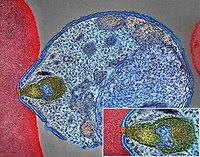
Photo from wikipedia
Assays used to evaluate the transmission-blocking activity of antimalarial drugs are largely focused on their potential to inhibit or reduce the infectivity of gametocytes, the blood stages of the parasite… Click to show full abstract
Assays used to evaluate the transmission-blocking activity of antimalarial drugs are largely focused on their potential to inhibit or reduce the infectivity of gametocytes, the blood stages of the parasite that are responsible for the onward transmission to the mosquito vector. For this purpose, the drug is administered concomitantly with gametocyte-infected blood, and the results are evaluated as the percentage of reduction in the number of oocysts in the mosquito midgut. We report the results of a series of experiments that explore the transmission-blocking potential of two key antimalarial drugs, artesunate (AS) and sulfadoxine-pyrimethamine (SP), when administered to mosquitoes already infected from a previous blood meal. For this purpose, uninfected mosquitoes and mosquitoes carrying a 6 day old Plasmodium relictum infection (early oocyst stages) were allowed to feed either on a drug-treated or an untreated host in a fully factorial experiment. This protocol allowed us to bypass the gametocyte stages and establish whether the drugs have a sporontocidal effect, i.e. whether they are able to arrest the ongoing development of oocysts and sporozoites, as would be the case when a mosquito takes a post-infection treated blood meal. In a separate experiment, we also explored whether a drug-treated blood meal impacted key life history traits of the mosquito relevant for transmission, and if this depended on their infection status. Our results showed that feeding on an AS- or SP-treated hosts has no epidemiologically relevant effects on the fitness of infected or uninfected mosquitoes. In contrast, when infected mosquitoes fed on an SP-treated host, we observed both a significant increase in the number of oocysts in the midgut, and a drastic decrease in both sporozoite prevalence (-30%) and burden (-80%) compared with the untreated controls. We discuss the potential mechanisms underlying these seemingly contradictory results and contend that, provided the results are translatable to human malaria, the potential epidemiological and evolutionary consequences of the current preventive use of SP in malaria-endemic countries could be substantial.
Journal Title: International journal for parasitology
Year Published: 2021
Link to full text (if available)
Share on Social Media: Sign Up to like & get
recommendations!